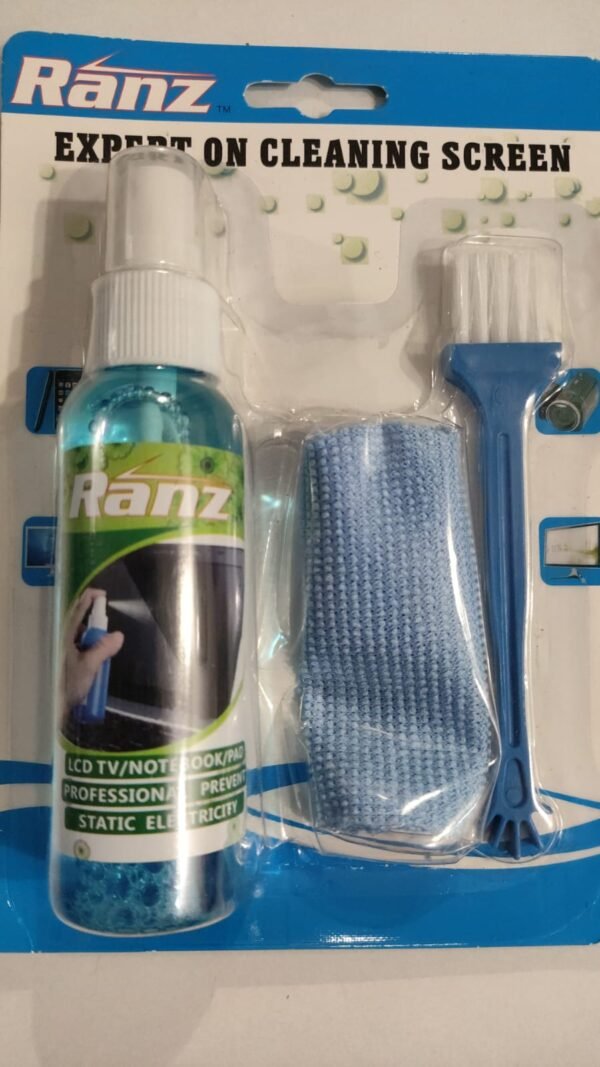Laptop Screen Cleaning Kit
Original price was: ₹599.00.₹251.00Current price is: ₹251.00. Including tax | 1 users are viewing this product Save ₹348.00 (58%)
Availability: 20 in stock
Understanding Different Screen Types and Their Specific Cleaning Needs
Screen technology has evolved dramatically in recent years, with various types populating our households and workplaces. Common screen types include LED, LCD, OLED, and touchscreens. Each of these screens has unique characteristics and necessitates specific cleaning approaches to maintain their functionality and longevity.
LED (Light Emitting Diode) screens are known for their bright display and energy efficiency. However, their sensitivity to harsh chemicals necessitates the use of gentle, specialized cleaning solutions. Similarly, LCD (Liquid Crystal Display) screens, which offer high-definition visuals, are vulnerable to pressure and abrasive materials. Cleaning them with a soft microfiber cloth dampened with a water and isopropyl alcohol mixture is recommended.
OLED (Organic Light Emitting Diode) screens, commonly used in high-end devices, offer superior color accuracy and contrast. Nonetheless, their organic compounds can degrade with harsh cleaners. Hence, it is crucial to use non-alcoholic, ammonia-free products to clean OLED screens. Touchscreens, prevalent in smartphones and tablets, combine aspects of the aforementioned screens but also bear the brunt of direct physical contact, making them prone to fingerprints and grime. They should be cleaned regularly with gentle, lint-free cloths and appropriate cleaners.
Identifying your screen type is the first step in ensuring you use the correct cleaning method. This information is generally available in the product manual or manufacturer’s website. Using the wrong cleaning materials can lead to various forms of damage including scratches, streaks, and reduced screen quality.
There are several basic dos and don’ts for maintaining your screen. Always power off and unplug the device before cleaning. Avoid utilizing paper towels, which can scratch the surface, and eschew spraying liquid directly onto the screen. Instead, lightly moisten a microfiber cloth and gently wipe the screen in a circular motion.
Improper cleaning techniques not only compromise the visual quality of your screens but may also void warranties. Therefore, understanding the specific needs of different screen types is paramount for preserving their integrity and ensuring a clear viewing experience.
Step-by-Step Expert Techniques for Cleaning Your Screen Safely and Effectively
To clean your screen like an expert, you will need the right tools and materials. Essential items include microfiber cloths, distilled water, and specific screen cleaning solutions. These specialized tools ensure that your screens are cleaned effectively without causing damage.
Preparation is key to any successful cleaning endeavor. Begin by turning off your device and disconnecting it from any power sources. This not only ensures safety but also makes it easier to see the dust and smudges on your screen.
Start with a light dusting of the screen using a dry microfiber cloth. This removes loose particles and prevents them from scratching the screen during the cleaning process. After dusting, it’s crucial to apply the cleaner to the cloth rather than directly to the screen. Direct application of liquid can lead to excess moisture seeping into the edges and potentially damaging internal components.
When wiping the screen, use gentle circular motions. This technique helps in evenly distributing the cleaning solution and reducing streaks. Be thorough but gentle, and avoid applying too much pressure to prevent damage. After cleaning, make sure that all residues from the cleaning solution are completely removed. This often requires a second pass with a dry microfiber cloth to absorb any remaining moisture.
Employing best practices while cleaning screens is essential. Avoid using abrasive materials, excessive moisture, and harsh chemicals, as these can damage the delicate surface of the screens. Stick to products specifically designed for screen cleaning to ensure longevity and clarity.
For ongoing maintenance, consider using protective covers to shield screens from dust and fingerprints. Regularly wiping down screens with a microfiber cloth can prevent the buildup of grime and make deep cleaning sessions less frequent.
By following these expert techniques and tips, you can keep your screens looking pristine and functioning well for years to come. Regular maintenance, combined with careful cleaning practices, is the key to extending the life and clarity of your screens.












Reviews
There are no reviews yet.